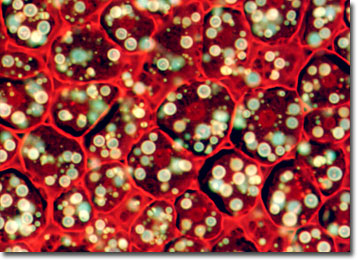Fluorescence Digital Image Gallery
Corn Grain
Corn is the common name for the cereal grass widely grown as food for humans and animals. Along with wheat and rice, it is one of the world's chief grain crops and the largest crop grown in the United States. Native to the Americas, corn, scientifically described as Zea mays, is the domesticated variety of the Zea grass family, originally cultivated by Native Americans 8,000 to 10,000 years ago.

Teosinte (Zea mexicana), a perennial wild corn once thought to be extinct, still grows today in Mexico. Since its introduction into Europe in the fifteenth century, corn cultivation has spread to all areas of the world where it can be grown. In addition to providing food for human consumption, corn is also used as livestock feed. The inedible parts, such as the cob and husk, are used as raw material in industry.
There are many varieties of domestic corn, most of which were developed through aggressive breeding programs during the twentieth century. The most important advance in corn cultivation came in 1933, with the introduction of hybrids. The thousands of hybrids that have been produced since then have increased corn yields and made it possible for the crops to flourish in almost any combination of soil and climate. Since the rediscovery of teosinte in 1978, new breeding programs have been underway to develop a perennial corn variety and hardier, pest resistant plants.
Corn plants have an erect, solid stem, rather than the hollow stem characteristic of most other grasses. They vary widely in height, from 2 feet to 18 feet, depending on the variety. The plants have long narrow leaves that grow alternately along the length of the stalk. Each stalk terminates with a tassel bearing tiny flowers that produce pollen, the male gamete. The ear, covered by modified leaves called husks, is the pistillate (female) part of the plant and bears up to 1,000 seeds. A cluster of silk fibers protrudes from the tip of the ear, each fiber attached to an individual ovary. Pollen from the tassels is carried by the wind and falls onto the silks. There, it germinates and grows down through the silk until it reaches the ovary, each of which develops into a kernel of corn.
The specimen presented here was imaged with a Nikon Eclipse E600 microscope operating with fluorite and/or apochromatic objectives and vertical illuminator equipped with a mercury arc lamp. Specimens were illuminated through Nikon dichromatic filter blocks containing interference filters and a dichroic mirror and imaged with standard epi-fluorescence techniques. The specific filter for the corn grain stained thin section was a DAPI, FITC, Texas Red combination. Photomicrographs were captured with an Optronics MagnaFire digital camera system coupled to the microscope with a lens-free C-mount adapter.
BACK TO THE FLUORESCENCE DIGITAL IMAGE GALLERY
